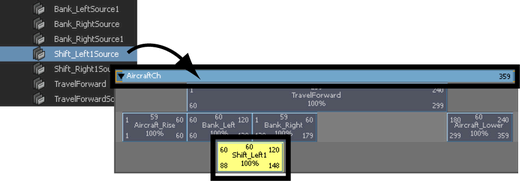You can save and reuse clips for future use. You can key specific types of motion or attribute effects, save them as clips, and reuse the clips for other characters.
When you reuse a clip created for one character and apply it to another, the clip attributes must be mapped to correspond between the two characters.
In this lesson, you work with clips created for this aircraft animation. The clips contain animation to make the aircraft shift to the left and right and bank left and right.
A file browser appears. When importing a clip, the file browser defaults to the clip directory of your current project.
The clip is imported and appears in the Outliner named as Bank_LeftSource to indicate it is a source clip.
When you have finished, four new clips appear in the Outliner as source clips. In the steps that follow, you place and position the clips on tracks in the Trax Editor.
When you import clips they also appear in, and can be accessed from, the Visor (Window > General Editors > Visor). The Visor is a graphical interface that allows you to import items that reside on disk or in your current file (files, textures, clips poses, and so on). Clips that are assigned to a character in Trax will appear listed under the Character Clips tab in the Visor. Clips that have not yet been placed on a track will appear listed in the Visor under the Unused Clips tab.
To place clips into a track from the Outliner



You can also drag clips from the Outliner or Visor into the Trax Editor and create a new track for them to be placed in.

A new track appears in the Trax Editor and the clip is placed on the new track.
The narrow blue box is the summary track for the character set (in this case the Aircraft) The summary track represents all of the clips under a character, subcharacter, or group. When you import a clip onto the summary area by dragging it from the Outliner or Visor, the Trax Editor creates a new track for the clip.

Because the Shift_Left clip is positioned directly below the Bank_Left clip, the actions will occur simultaneously when the animation is played back.

The view updates to display the aircraft from a perspective view.

After the aircraft rises, it travels forwards as before but now it shifts sideways to the left while one wing tips downwards, and then shifts sideways to the right, while the opposite wing tips downwards.